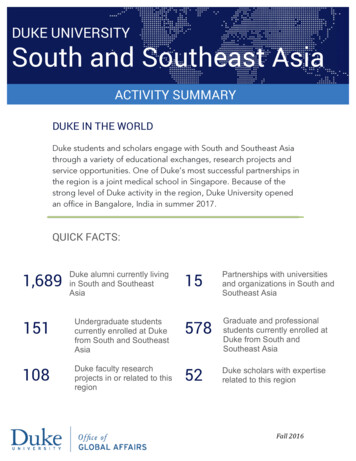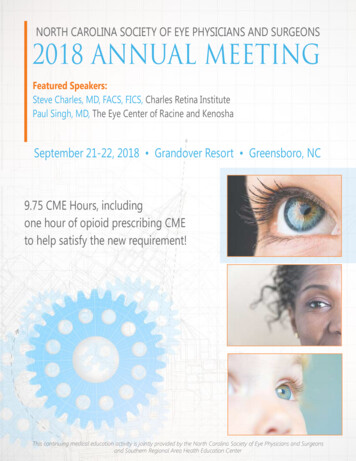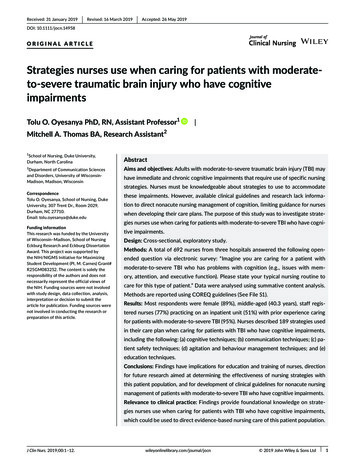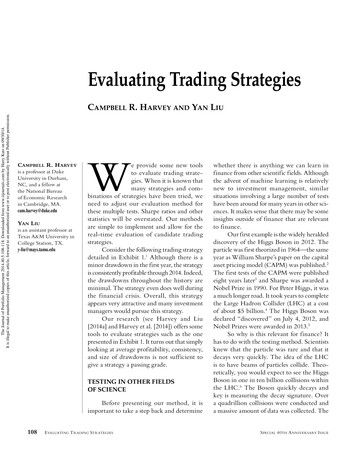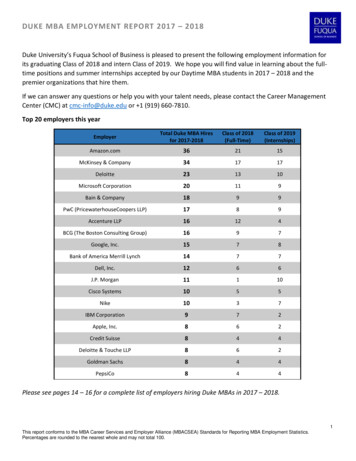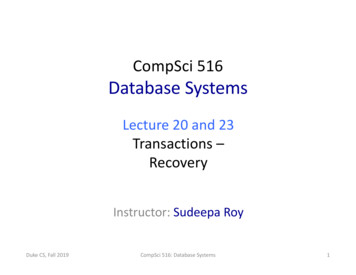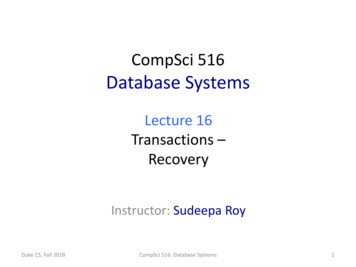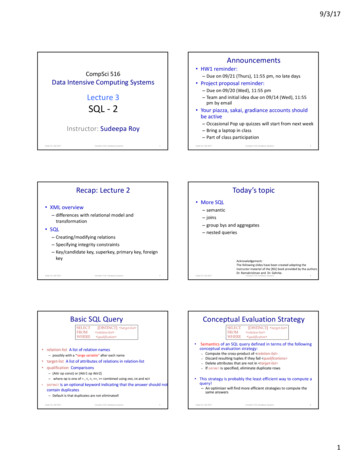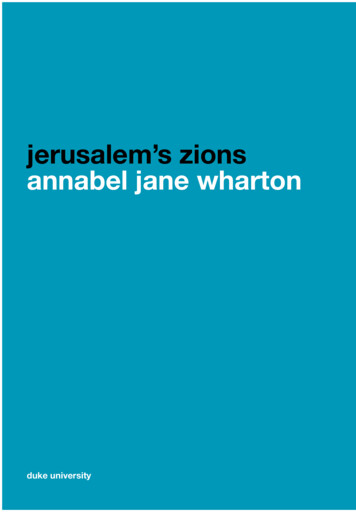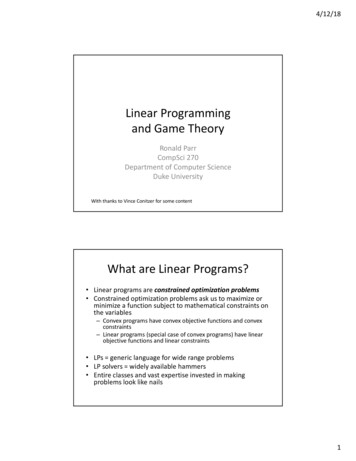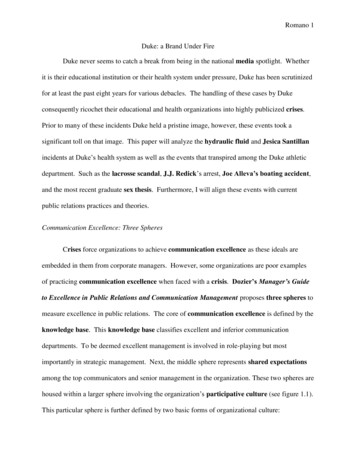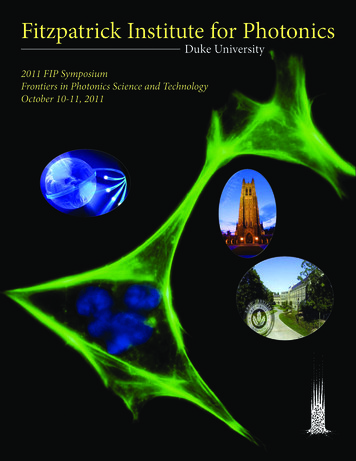
Transcription
Fitzpatrick Institute for PhotonicsDuke University2011 FIP SymposiumFrontiers in Photonics Science and TechnologyOctober 10-11, 2011
“Photonics has been at the heart of theinformation technology revolution,and it can have similar impact inmany critical areas such as medicineat the point-of-care, energy, nationaldefense, and global health.”Tuan Vo-Dinh, Ph.D.Director of theFitzpatrick Institute for PhotonicsR. Eugene and Susie E. GoodsonProfessor of Biomedical EngineeringProfessor of Chemistry
Welcome to the Fitzpatrick Institute for PhotonicsSymposium on Photonics Science and Technology2011 FIP Annual MeetingOctober 10-11, 2011, Duke UniversitySymposium Chair – Tuan Vo-Dinh, Director, Fitzpatrick Institute for PhotonicsScientific Program Committee – Jungsang Kim, Daniel Gauthier, David Beratan, Joseph Izatt, Nan Jokerst,Kam Leong, Barry Myers, William Reichert, David Smith, Warren Warren, Adam Wax, Weitao YangSymposium Administrative Manager – August Burns, Business Manager, Fitzpatrick Institute for PhotonicsAssistant Coordinator – Yan Zhang, Lab Manager, Fitzpatrick Institute for PhotonicsMonday, October 10, 2011Fitzpatrick Building8:00 am - 9:00 am Registration9:00 am - 5:00 pm Meeting5:00 pm Poster Session-ReceptionTuesday, October 11, 2011Fitzpatrick Building8:30 am - 9:00 am Registration9:00 am - 12:00 pm Meeting
Symposium on Photonics Science and Technology2011 Fitzpatrick Institute for Photonics (FIP) Annual MeetingOctober 10-11, 2011, Duke UniversityThe Fitzpatrick Institute for Photonics is an extensively interdisciplinary Duke effort to advance photonics andoptical sciences. The institute leverages Duke’s faculty from the Pratt School of Engineering, Trinity Arts andSciences, and the Duke Medical School to explore problems at the boundary nexus of nano-bio-info-opto convergence.The Fitzpatrick Institute for Photonics (FIP) has 82Faculty Members from 27 Participating Departments,Centers & Institutions at Duke UniversityDepartments – Anesthesiology Biology Biomedical Engineering (BME) Chemical Biology Chemistry Civil & Environmental Engineering (CEE) Computer Science Electrical and Computer Engineering (ECE) Gastroenterology Mathematics Mechanical Engineering and Materials Science (MEMS) Neurosurgery Oncology Ophthalmology Orthopaedic Engineering Pathology Pediatrics Physics Radiation Oncology Radiology SurgeryCenter for Metamaterials & Integrated PlasmonicsDivision of Infectious Diseases & International HealthDuke Comprehensive Cancer CenterDuke Human Vaccine InstituteInstitute for Genome Science and PolicyNicholas School of the EnvironmentFIP Research Programsand Program DirectorsBiophotonics – Joseph IzattNano/Micro Systems – Nan JokerstQuantum Optics andInformation Photonics – Daniel GauthierPhotonic Materials – David SmithAdvanced PhotonicSystems – William “Monty” ReichertNanophotonics – Kam LeongSystems Modeling, Theory &Data Treatment – Weitao YangNovel Spectroscopies – Warren Warren
Symposium on Photonics Science and Technology2011 Fitzpatrick Institute for Photonics (FIP) Annual MeetingOctober 10-11, 2011, Duke UniversityADVANCE PROGRAMMonday, October 10 (Fitzpatrick Center) – Morning Session8:00-9:00 amRegistration9:00-9:10Welcome AddressPeter Lange, Provost, Duke University9:10-9:25Opening RemarksTom Katsouleas, Professor and Dean, Pratt School of Engineering, Duke UniversityTuan Vo-Dinh, FIP Director, R. Eugene and Susie E. Goodson Professor ofBiomedical Engineering and Professor of Chemistry, Duke University9:25-10:15Symposium Keynote: “GFP: Lighting Up Life” – Martin Chalfie, Nobel Laureate inChemistry (2008), William R. Kenan Jr. Professor of Biological Sciences,Columbia University10:15-10:30FIP Award Presentation – 2011 Pioneer in Photonics Award10:30-10:45Coffee Break10:45-11:55Session 1: Duke Distinguished LecturesProvostPeter Lange10:45-11:20“Surfing on a Laser Wave: The Grand Challengeof Extending the High Energy Frontier”– Tom Katsouleas, Professor and Dean, Pratt Schoolof Engineering, Duke University11:20-11:55“Managing Interference” – Robert Calderbank, Professorand Dean of Natural Sciences, Duke University12:00-1:20 pmLunch Break(Lunch Boxes Provided)We invite you to attend the Poster Session Exhibit throughout the Symposium.Posters are exhibited in the Atrium area of the Fitzpatrick Center
Symposium on Photonics Science and Technology2011 Fitzpatrick Institute for Photonics (FIP) Annual MeetingOctober 10-11, 2011, Duke UniversityMonday, October 10 (Fitzpatrick Center) – Afternoon Session1:20-2:00 pmPlenary Lecture: “Quantum Computers and Raising Schrödinger’s Cat” – David J.Wineland, NIST Fellow, National Institute of Standard and Technology2:00-3:00Session 2: Quantum ArchitecturesChair: Jungsang Kim, Associate Professor, Department of Electrical and ComputerEngineering, Physics and Computer Science, Duke University2:00-2:30Invited Lecture: “Quantum Networks of Trapped Ions”– Christopher Monroe, Bice Zorn Professor of Physics, JointQuantum Institute, University of Maryland2:30-3:00Invited Lecture: “Challenges in Quantum Computer Architecture”– Kenneth Brown, Blanchard Assistant Professor, Schoolof Chemistry and Biochemistry, School of Computational Scienceand Engineering, and School of Physics, Georgia Instituteof Technology3:00-3:203:20-5:00Coffee Break and Poster SessionSession 3: Scalable Systems and TechnologiesChair: Daniel Gauthier, Robert C. Richardson Professor of Physics, Duke University3:20-3:50Invited Lecture: “Quantum information processing withRydberg atoms” – Mark Saffman, Professor of Physics, Universityof Wisconsin-Madison3:50-4:20Invited Lecture: “Robust microfabricated surface ion traps witharbitrary lateral geometries” – David Moehring, Senior ResearchStaff, Sandia National Laboratories4:20-4:40“Integration Technologies for Scalable Quantum InformationProcessing with Trapped Ions” – Jungsang Kim, Associate Professorof Electrical and ComputerEngineering, Physics and Computer Science, Duke University
Symposium on Photonics Science and Technology2011 Fitzpatrick Institute for Photonics (FIP) Annual MeetingOctober 10-11, 2011, Duke University4:40-5:005:00-6:30“Colloidal Quantum Dot-Conducting Polymer Nanocomposites forMulti-spectral Photodetection” – Adrienne Stiff-Roberts, AssistantProfessor of Electrical and Computer Engineering, Duke UniversityPoster SessionJudge: Bernard Fischer, Associate Professor of Pediatrics, Duke UniversityJudge: Jie Liu, Professor of Chemistry, Duke UniversityJudge: Fan Yuan, Professor of Biomedical Engineering, Duke UniversityWe invite you to attend the Poster Session Exhibit throughout the Symposium.Posters are exhibited in the Atrium area of the Fitzpatrick CenterTheme Lab Visits (see Registration Desk for participation)5:30-6:30Cocktail Reception(Heavy hors d’oeuvres will be served)Tuesday, October 11, (Fitzpatrick Center)SPECIAL EDUCATION PROGRAM FOR HIGH-SCHOOL STUDENTSIntroduction of high school students to science and engineeringBreakfast with a NOBEL LAUREATEfeaturing Dr. Martin Chalfie, who received the 2008 Nobel Prizefor his discovery and development of the green fluorescent protein (GFP)
Symposium on Photonics Science and Technology2011 Fitzpatrick Institute for Photonics (FIP) Annual MeetingOctober 10-11, 2011, Duke UniversityTuesday, October 11 (Fitzpatrick Center) Morning Session8:30-9:00 am9:00-10:20RegistrationSession 4: Quantum CommunicationsChair: Harold Baranger, Professor of Physics, Duke University9:00-9:30Invited Lecture: “Hyperentanglement: More IS better” – PaulKwiat, John Bardeen Professor of Physics and of Electrical andComputer Engineering, University of Illinois9:30-10:00Invited Lecture: “Light in a Twist: optical orbital angularmomentum” – Miles Padgett, Professor of Optics and Astronomy,University of Glasgow, United Kingdom10:00-10:20“Information Capacity of a Single Photon” – Daniel Gauthier,Robert C. Richardson Professor of Physics, Duke University10:20-10:4010:40-12:00Coffee BreakSession 5: Quantum OpticsChair: Adrienne Stiff-Roberts, Assistant Professor in Electrical and ComputerEngineering, Duke University10:40-11:10Invited Lecture: “Parallel generation of 15 quadripartite entangledstates in the optical frequency comb” – Olivier Pfister, Professor ofPhysics at University of Virginia11:10-11:40Invited Lecture: “Auxiliary Entanglement in SpontaneousParametric Down-Conversion” – Warren Grice, Senior ResearchScientist at Oak Ridge National Laboratory11:40-12:00“Flying Qubits for Quantum Networks: Photon Blockade Withouta Cavity” – Harold Baranger, Professor of Physics, Duke University12:00-12:10 pmPoster Awards12:10 pmSymposium Adjourns
Keynote SpeakerMartin Chalfie, Ph.D.Nobel Laureate in Chemistry (2008)William R. Kenan, Jr. Professor of Biological SciencesColumbia University“GFP: Lighting Up Life”Yogi Berra once said, “You can observe a lot by watching.” Unfortunately, before theearly 1990s observations in the biological sciences were usually done on dead specimens that were specially prepared and permeabilized to allow entry of reagents tostain cell components. These methods allowed a glimpse of what cells were doing,but they gave a necessarily static view of life, just a snapshot in time. GFP and otherfluorescent proteins revolutionized the biological sciences because these proteins allowed scientists to lookat the inner workings of living cells. GFP can be used to tell where genes are turned on, where proteins arelocated within tissues, and how cell activities change over time. Once a cell can be seen, it can be studiedand manipulated. I will provide some examples of how having a dynamic view of life opens up new andexciting avenues of research. The discovery and development of GFP also provide a very nice example ofhow scientific progress is often made: through accidental discoveries, the willingness to ignore previousassumptions and take chances, and the combined efforts of many people. The story of GFP also shows theimportance of basic research on non-traditional organisms.Martin Chalfie is the William R. Kenan, Jr. Professor of Biological Sciences and former chair of the Department of Biological Sciences at Columbia University. In 2008 he shared the Nobel Prize in Chemistrywith Osamu Shimomura and Roger Y. Tsien for his introduction of Green Fluorescent Protein (GFP) as abiological marker.Dr. Chalfie was born in Chicago, Illinois. He obtained both his A.B. and Ph.D. from Harvard Universityand then did postdoctoral research with Sydney Brenner at the MRC Laboratory of Molecular Biology,Cambridge, England. He joined the faculty of Columbia University as an Assistant Professor in 1982 andhas been there ever since.He uses the nematode Caenorhabditis elegans to investigate nerve cell development and function, concentrating primarily on genes used in mechanosensory neurons. His research has been directed toward answering two quite different biological questions: How do different types of nerve cells acquire and maintain their unique characteristics? and How do sensory cells respond to mechanical signals? In the course ofhis studies, he has introduced several novel biological methods in addition to his work with GFP.Dr. Chalfie is a member of the National Academy of Sciences and the Institute of Medicine and a fellow ofthe American Academy of Arts and Sciences, the American Association for the Advancement of Science,the Institute of Medicine, and the Royal Society of Chemistry (Hon.). He shared the 2006 Lewis S. Rosenstiel Award for Distinguished Work in Basic Medical Science from Brandeis University and the 2008 E. B.Wilson Medal from the American Society for Cell Biology with Roger Tsien.
Fitzpatrick Institute for Photonics FacultyPLENARY SPEAKERDave J. Wineland, Ph.D.2007 National Medal of Science AwardeePhysicist, National Institute of Standards and Technology“Quantum Computers and Raising Schrödinger’s Cat”Quantum systems such as atoms can be used to store information. For example, we can storebinary information in two energy levels of an atom by labeling the state with lower energy a “0”and the state with higher energy a “1.” However, quantum systems can also exist in superposition states, thereby storing both states of the bit simultaneously - a situation that makes no sense in our ordinary-dayexperience. This property can lead to an increase in memory and processing capacity that scales exponentially withthe number of bits. It would enable a quantum computer to efficiently solve certain problems such as factorizinglarge numbers, which may be intractable on a classical computer. Actually building a useful quantum computer is anextremely daunting task due to the necessity of overcoming decoherence, which includes all processes that destroysuperposition states. Nevertheless, in the near term, the principles of quantum information processing are findingapplications in metrology such as for atomic clocks. A small quantum processor would also realize a mesoscopic version of “Schrödinger’s Cat,” a bizarre situation conceived by Erwin Schrödinger in 1935 where a cat could be simultaneously dead and alive. A number of physical systems are currently considered for building a quantum computer;this talk will focus on the use of trapped atomic ions.David Wineland received a bachelor’s degree from Berkeley in 1965 and his Ph.D. from Harvard in 1970, under Norman Ramsey. After a postdoctoral appointment at the University of Washington, under Hans Dehmelt, he joinedNBS (now NIST), where he is the leader of the Ion-Storage Group in the Time and Frequency Division at Boulder.The group’s research has focused on laser cooling and spectroscopy of trapped atomic ions with applications toatomic clocks, quantum-limited metrology, and quantum state control. Dr. Wineland was awarded the 2007 NationalMedal of Science from President George W. Bush for his “outstanding leadership in developing the science of lasercooling and manipulation of ions, with applications in extremely precise measurements and standards, quantumcomputing, and fundamental tests of quantum mechanics, and for his major impact on the international scientificcommunity through training scientists and outstanding publications.”**http://www.nist.gov/public affairs/releases/wineland082508.cfm
Duke Distinguished SpeakersRobert Calderbank, Ph.D.Dean of the Natural SciencesProfessor of Computer Science, Mathematics,Electrical and Computer EngineeringDuke University“Managing Interference”We consider a new framework for full-duplex communication in ad-hoc wireless networks. An individualnode in the wireless network either transmits or it listens to transmissions from other nodes but it cannot toboth at the same time. There might be as many nodes as there are 48 bit MAC addresses but we assume thatonly a small subset of nodes contribute to the superposition received at any given node in the network.We use ideas from compressed sensing to show that simultaneous communication is possible across the entire network. Our approachis to manage interference through configuration and it makes use of quantum error correcting codes.Robert Calderbank is Dean of Natural Sciences and Professor of Electrical Engineering at Duke University where he directs a researchprogram at the interface of signal processing and wireless communication. Prior to joining Duke in 2010, he was Director of the Program in Applied and Computational Mathematics at Princeton University, and before joining Princeton in 2004 he was Vice Presidentfor Research at AT&T. At the start of his career at Bell Labs Professor Calderbank developed technology that was incorporated in a progression of voiceband modem standards that moved communications practice close to the Shannon limit. Together colleagues at AT&TLabs he showed that good quantum error correcting codes exist and developed the group theoretic framework for quantum errorcorrection. He is a co- inventor of space-time codes for wireless communication, where correlation of signals across different transmitantennas is the key to reliable transmission. Professor Calderbank was elected to the US National Academy of Engineering in 2005.Tom Katsouleas, Ph.D.Dean, Pratt School of EngineeringProfessor of Electrical and Computer EngineeringDuke University“Surfing on a Laser Wave: The Grand Challengeof Extending the High Energy Frontier”Particle accelerators are among the largest and most successful machines ever built by humans. They havebeen responsible for more discoveries about the fundamental nature of matter and energy than any other tool. However, they haveclearly hit limits of size and cost, and the continued exploration of the high energy physics frontier as well as the realization of promising applications in medicine and industry require a new technology. Plasma-based accelerators have emerged as the leading candidate.Acceleration of particles in plasma waves driven by lasers and particle beams have made remarkable advances in the past five years,including the doubling of the energy of the 3km long Stanford Linear Accelerator in a one-meter long plasma and the generation ofGeV monoenergetic beams in a centimeter long gas/plasma. This talk reviews the recent history and basic principles of plasma-basedacceleration and highlights simulation advances and upcoming experiments that will take the field the next step toward the energyfrontier. The talk will examine the role of accelerators and plasmas in addressing the NAEs Grand Challenges for the 21st Century.Thomas C. Katsouleas became dean of Duke University’s Pratt School of Engineering, in July 2008, where he is also a Professor ofElectrical and Computing Engineering. He earned a Ph.D. in physics and B.S. in physics, from UCLA in 1979 and 1984, respectively.He continued at UCLA where he served for seven years on the faculty. He joined the University of Southern California faculty as anassociate professor of electrical engineering in 1991, becoming full professor in 1997. There he also served as an Associate Dean ofEngineering and Vice Provost of Information Technology Services. He currently serves as associate editor of the IEEE Transactions onPlasma Science, co-chair of the ASEE Global Symposium on Engineering Education (Shanghai, 2011) and chair of the National Academy of Engineering Advisory Committee on Grand Challenges. Katsouleas’ primary research interest is in the use of plasmas as novelparticle accelerators and light sources. His talk today reprises his award address for the 2011 Plasma Science Achievement Award fromthe IEEE.
Invited SpeakersKenneth Brown, Ph.D.Blanchard Assistant ProfessorSchools of Chemistry and Biochemistry; Computational Science and Engineering; and PhysicsGeorgia Institute of Technology“Challenges in Quantum Computer Architecture”The development of a large-scale quantum computer faces two challenges: faulty hardware components and the inability to copy quantum information. Despite the no-cloning theorem, it is possible to use fault-tolerant quantum error correction techniques to generatearbitrarily reliable logical components. In the context of an algorithm, the inability to copy quantum information requires that a blockof data that needs to interact with two other data blocks must be transported first from one block and then to the other. Although it iswidely appreciated that the bulk of resources in a scalable quantum computers will be devoted to error correction, the significant costof communication in the computer is only now being understood [1]. I will discuss methods for estimating the communication coston two distinct hardware layouts for ion trap quantum computation in the context of concatenated error correcting codes. In the firsthardware layout, the ions are held in multiple zones and communications is performed by physically shuttling ions between zones [2].The second hardware layout uses photons to create entangled ions in distant traps by the process of heralded entanglement [3]. Theseentangled ions are then used as teleportation channels to transfer information. I will compare possible architectures for arranging thesesystems on the logical level. Finally, I will briefly describe how these same architectural ideas can be applied in the setting of topologicalerror correction.[1] M.G. Whitney, N. Isailovic, Y. Patel and J. Kubiatowicz, A Fault Tolerant, Area Efficient Architecture for Shor’s Factoring Algorithm, Proc. of the 39th Annual Intl. Symp. on Computer Architecture ( ISCA), 383 (2009).[2] D. Kielpinski, C. Monroe & D. J. Wineland, Architecture for a large-scale ion-trap quantum computer, Nature 417, 709 (2002).[3] L.-M. Duan and C. Monroe, Quantum Networks with Trapped Ions, Rev. Mod. Phys. 82, 1209 (2010).Kenneth Brown received his B.S. in Chemistry from the University of Puget Sound in 1998. For his PhD, he studied theoreticalquantum information science as a Hertz Fellow at UC Berkeley. Following his PhD, he held a postdoctoral position at MIT where heperformed quantum information experiments using NMR and ion traps. Since 2007, he has been an assistant professor at Georgia Techwhere he leads a research group studying quantum information and cold molecular ions.
Warren Grice, Ph.D.Senior Research ScientistCenter for Quantum Information ScienceOak Ridge National Laboratory“Auxiliary Entanglement in Spontaneous Parametric Down-Conversion”In most photonic quantum information applications, information is encoded into the photons’ polarization degrees of freedom. This is a natural choice, given that polarization can be completely described by a linear combination of onlytwo basis states. It has experimental appeal, as well, since it is relatively easy to manipulate polarization using simple optical elements.However, a more complete description of the photon also includes its energy and its spatial mode. And while it might seem that thesehave little to do with polarization, it turns out that spatial and spectral entanglement can have adverse effects in polarization entanglement experiments. I will discuss the source of these auxiliary entanglements and will present a series of theoretical and experimentalresults illustrating the subtle relationships between various types of entanglement. Strategies for managing these auxiliary entanglements will also be discussed.Dr. Warren Grice is a senior research scientist at Oak Ridge National Laboratory and serves as the director of its Center for QuantumInformation Science. He conducts research primarily in the field of quantum optics, particularly in the design and fabrication of novelsources of entangled photons. Recent projects include entangled photon sources for Quantum Key Distribution and Quantum Computing. Dr. Grice holds a B.S. in Physics from Western Kentucky University and a Ph.D. in Optics from the University of Rochester(1997), where his thesis work on ultrafast quantum optics was completed under the direction of Ian Walmsley. Before coming to ORNL,Dr. Grice was a member of the faculty of the Department of Physics at Southern Illinois University Edwardsville.Paul G. Kwiat, Ph.D.John Bardeen Professor of PhysicsProfessor of Electrical and Computer EngineeringUniversity of Illinois“Hyperentanglement: More IS better”Entanglement is now seen as one of the critical resources in the new field of quantum information processing. For example, it enables ultra-secure quantum cryptography and teleportation. However, onlyrecently have researchers begun to explore the fact that two parties, e.g., photons, can in fact be simultaneously entangled in multipledegrees of freedom. Here we discuss the benefits of such “hyperentanglement”, focusing on its use for high-capacity quantum communication and high-speed quantum cryptography.Paul G. Kwiat is the Bardeen Chair in Physics, at the University of Illinois, in Urbana-Champaign. A Fellow of the American PhysicalSociety and the Optical Society of America, and recipient of the OSA 2009 R. W. Wood Prize, he has given invited talks at numerousnational and international conferences, and has authored over 130 articles on various topics in quantum optics and quantum information, including several review articles. His research includes the phenomena of quantum interrogation, quantum erasure, and opticalimplementations of quantum information protocols, particularly using entangled—and hyperentangled—photons from parametricdown-conversion.
David Moehring, Ph.D.Senior Research StaffSandia National Laboratories“Robust microfabricated surface ion traps with arbitrary lateral geometries”We will present the status of Sandia’s efforts to engineer surface ion traps, specifically detailing our ability to reliably fabricate arbitrary surface geometries. These achievements include the precision placement of backside holes for loading from a neutral atom source, multi-level metalization which supportsvertical interconnects and low electrical power loss in the substrate, and low profile wirebonds for surface laser access [1, 2]. We havecombined these capabilities to produce a successful and robust Y-junction trap which takes advantage of numerical simulations to tailorthe RF pseudopotential field in the junction with precisely shaped electrodes [3]. We will also present ongoing collaborative work atfabricating structures for quantum simulations. In addition we will describe traps with an integrated high finesse optical cavity, junction traps capable of reordering strings of ions with multiple species, and ring shaped traps.[1] D. Stick, et al., arXiv:1008.0990v2 [physics.ins-det] (2010).[2] D. T. C. Allcock, et al., arXiv:1105.4864v1 [quant-ph], accepted for publication (2011).[3] D. L. Moehring, et al., New J. Phys. 13, 075018 (2011).Sandia National Laboratories is a multi-program laboratory managed and operated by Sandia Corporation, a wholly owned subsidiaryof Lockheed Martin Corporation, for the U.S. Department of Energy’s National Nuclear Security Administration under contract DEAC04-94AL85000David Moehring has spent the last 10 years in quantum information processing specializing in the entanglement between single atomsand single photons. His Ph.D. in the group of Chris Monroe presented a theoretical and experimental realization for the entanglement of two trapped atomic ions, including the first explicit demonstration of quantum entanglement between a single trapped ion andits single emitted photon, as well as the entanglement between two macroscopically separated trapped ions. From 2007-2009, he wasan Alexander von Humboldt Research Fellow in the group of Gerhard Rempe at the Max Planck Institute for Quantum Optics wherehis research focused on the entanglement between a single photon and a single atom strongly coupled to a high-finesse optical cavity.Since 2009, David is been a Senior Member of Technical Staff at Sandia National Laboratories where he has led an effort developingmicrofabricated ion traps.Christopher Monroe, Ph.D.Bice Zorn Professor of PhysicsJoint Quantum InstituteUniversity of Maryland“Quantum Networks of Trapped Ions”Trapped atomic ions are among the most promising candidates for quantum information processing,with each atom typically storing a single quantum bit (qubit) of information in appropriate internal electronic levels. All of the fundamental quantum operations have been demonstrated between small numbers of atoms [1], and the central challenge now is how toscale the system to larger numbers of interacting qubits. The Coulomb interaction between trapped ions allows entangling operationsthrough the collective motion of the ion crystal, which is excited through the state-dependent optical dipole forces. Such a quantumnetwork may be limited in size by the stability and coherence of the motion of larger ion crystals, and current efforts are devoted to thephysical movement of individual atomic ions through complex ion trap structures [2] or alternatively by mapping qubits onto photons that can allow the probabilistic entanglement between remotely-located atomic crystals [3]. On the other hand, when such a laserforce is applied globally, an effective spin-spin interaction emerges whose sign and range can be precisely controlled with the laser [4],and any possible spin correlation function can be measured with standard state-dependent fluorescence techniques. This allows thequantum simulation of interesting spin models that possess nontrivial ground states for the investigation of quantum phase transitions, quantum frustration, and the emergence of spin liquid behavior. Work on all of these fronts will be reported, including quantumsimulations of magnetism with N 16 atomic qubits as well as progress on operating deterministic gates between atoms separated bymacroscopic distances.
[1][2][3][4]R. Blatt and D. J. Wineland, Nature 453, 1008 (2008).D. Kielpinski et al., Nature 417, 709 (2002).L.-M. Duan and C. Monroe, Rev. Mod. Phys. 82, 1209 (2010).R. Islam et al., Nature Comm. 2, 377 (2011).Christopher Monroe is an experimental physicist, in the realm of atomic, molecular and optical physics. After getting his undergraduate degree from MIT in 1987, Monroe obtained his PhD with Carl Wieman at the University of Colorado in 1992. From 1992-2000,Monroe joined the Ion Storage Group of David Wineland at the National Institute of Standards and Technology in Boulder, CO, asa National Research Council postdoctoral fellowship from 1992-1994, and a staff physicist in the same group from 1994-2000. WithWineland, Monroe led the research team that demonstrated the first quantum logic gate in 1995, and exploited the use of trappedatomic ions for applications in quantum control and the new field of quantum information science. Monroe was awarded the 1997Presidential Early Career Award for Scientists and Engineers and with Wineland shared the 2000 International Award for QuantumCommunications. In 2000, Monroe moved to the University of Michigan, where he developed the use of single photons to coup
– Christopher Monroe, Bice Zorn Professor of Physics, Joint Quantum Institute, University of Maryland . Miles Padgett, Professor of Optics and Astronomy, University of Glasgow, United Kingdom 10:00-10:20. Informat
